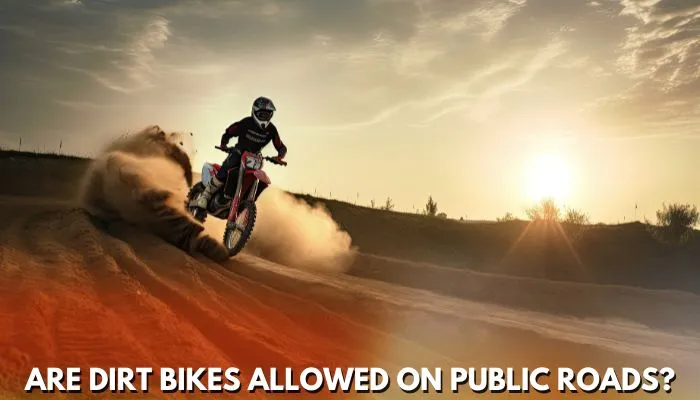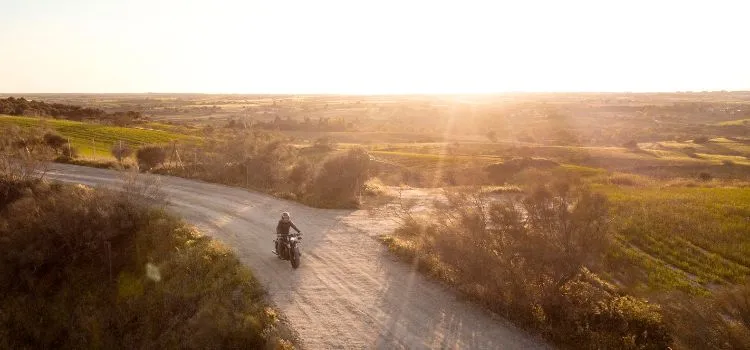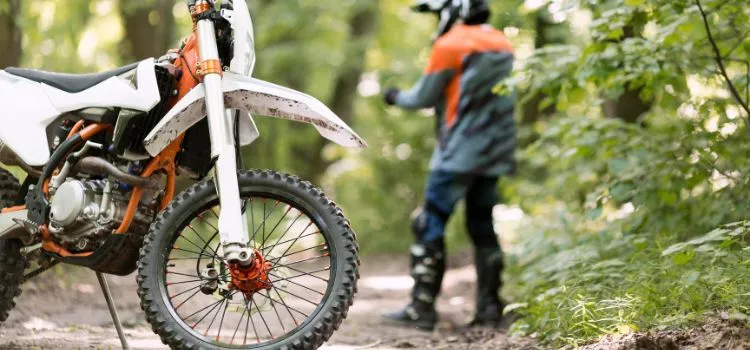Are Dirt Bikes Allowed On Public Roads?

Your desire to ride your dirt motorcycles on the road and that with numerous of your friends stems from riding them off-road. Right? However, you’re not even sure if riding a dirt bike on a roadway is something you can do. So the main question here is, Can you ride a dirt bike on the road?
Table of Contents
Short Answer
Although dirt bikes are designed for off-road riding, a rider may also use one on a public road in a safe and authorized manner. Riders must comply with a number of rules and requirements in order to ride a dirt bike on the road. To ride a dirt bike on the road, riders need a license, insurance, and a couple of additional items of machinery, such as DOT-approved bike tires, headlights, horns, turn signals, as well as brake lights.
Everything you need to be aware of when riding a dirt bike on a public road will be explained in this post. You’ll learn how to convert your dirt bike to a street-legal vehicle so you can use it on public roads, as well as other relevant details.
Can you ride a dirt bike on the road?
When the dirt bike is officially authorized, insured, and fitted with the required safety equipment, which might include the biking headlights, turning signals, and a horn, riding a dirt bike on an open road is typically legal. It is crucial to keep in mind, though, that dirt motorcycles are mostly made for off-road use and might not be as secure or pleasant for riding on asphalted surfaces.
You’ll notice that a street bike and a dirt bike often have very different appearances when compared side by side. Street bikes are frequently quite large and equipped with a variety of technology, such as stability control, ABS, and even digital display panels.
Dirt bikes are typically quite simple, though they do have larger suspensions to penetrate greater effects and tires that are rough rather than smooth to give them greater traction in the mud and dirt.
Furthermore, certain regions can have particular laws or regulations that limit or forbid the usage of dirt bikes on roadways that are public, so it’s necessary to verify with the local government before driving a dirt bike on the road.
Are dirt bikes legal on city streets?

In several states, dirt bikes are not permitted on public roads. In terms of driving vehicles used for off-on public roadways, all states have their own set of rules and restrictions. The same laws and rules that apply to conventional motorcycles may also apply to dirt bikes in some states, which classify them as motorcycles. However, in other states, they might be regarded as off-road vehicles and be governed by different laws.
Consulting the nearby The Department of Motor Vehicles or the authority’s office is the best method to find out whether dirt motorcycles are allowed on public roads in your state. If dirt motorcycles are permitted on public roads in your state, they will be able to inform you of the rules that apply.
What qualifies a dirt bike as a street-legal vehicle?
A dirt bike needs to meet a number of specifications and undergo modifications in order to be considered street-legal in the state or nation in which it will be used. For a dirt bike to be legally used on city streets, the following typical modifications are needed:
- Lights:
Both the headlights and the taillights on the bike must be at least as bright as necessary. These lights need to be operational at any point, particularly during the day.
- Turn signals:
Street use requires the use of turn signals. Both of these requirements must be met for them to be effective at a distance.
- Mirrors:
A minimum of a couple of mirrors that provide an unobstructed sight of the road in the back of you must be fitted on the bike.
- Horn:
A horn is necessary on the bike, and it must be detectable from a specific distance.
- Tires:
The bike must be equipped with street-legal tires that adhere to minimum tread depth as well as width standards.
- Registration and License Plate:
For a dirt motorcycle to be driven lawfully on public roads, it must have both of these necessary requirements.
- Exhaust system:
The dirt motorcycle must be equipped with an exhaust system that complies with all noise and emissions standards.
- Bike brakes:
The bike must have both front and rear brakes, and they must be in good operating order.
- Speedometer:
A speedometer must be mounted on the dirt bike to display the current rate of travel.
- Side stand and a kickstand:
A side stand and kickstand are essential to park the bike safely.
Mini Dirt Bikes: are they Legal on the Street?
Miniature dirt motorcycles are not permitted on public roads. There are several causes for this.
- First of all, most tiny dirt bikes lack the necessary safety measures to be allowed on public roads. The turn signals, braking lights, as well as mirrors, fall under this category.
- The two things needed to drive a vehicle on open roads—registration and insurance—are often absent from mini dirt motorcycles.
- Last but not least, the majority of tiny dirt motorcycles lack the certification for emissions needed to operate on public roads. This implies that they would be unable to successfully complete a smog test, which is necessary in many states.
Mini dirt motorcycles can be a great deal of pleasure to ride even if they are not allowed on public roads. You could benefit from them on the trails, or you can bring them to the track if you make an effort to make them legal. Simply make sure you ride defensively and adhere to traffic laws.
Reasons why dirt bikes are illegal on streets:

Since dirt bikes are made for off-road use, they should not be used on streets and highways that are open to the general public. There are a number of reasons why dirt motorcycles are normally prohibited on public streets:
- Safety features are missing
The same kinds of safety equipment that street-legal vehicles are supposed to have, such as headlights, taillights, turning signals, bike mirrors, and horns, are not included in the equipment on dirt bikes. To operate safely on public highways, you need to have these capabilities.
- Level of noise:
Due to their exceptionally powerful engines and combustion systems, dirt bikes frequently produce noise levels that are louder than those of street-legal cars. Loud exhaust systems may annoy other motorists and pedestrians as well as increase sound pollution in housing developments.
- Environmental Issues:
Compared to street-legal cars, dirt bikes frequently have more pollutants and lower fuel efficiency. This may exacerbate problems with air pollution and the environment.
- Lack of a valid driver’s license and insurance:
Drivers must have insurance when they drive a vehicle on public highways. Typically, dirt bikes are not insured or registered, which makes it illegal for them to be driven on public roadways.
- Off-Road Design:
Dirt motorcycles have components like long-travel suspension and knobby tires that are optimized for off-road use. These characteristics are not appropriate for secure functioning on asphalt roads and highways.
In conclusion, because of their absence of security measures, loud noise levels, potential environmental impact, and lack of a license and assurance, as well as off-road design, dirt bikes are often prohibited on public streets. When driving any kind of motor vehicle, it’s crucial to abide by local laws and ordinances constantly.
How to make your dirt bike ready to take on roads:
A few changes may need to be made to a dirt bike if you want to modernize it for road use in order to make it safe and allowed for use on public roads. You can follow the instructions listed below:
- Register your bike:
To get a license plate and register the dirt bike, you must register it with your local Department of Motor Vehicles. Additionally, you’ll need to have evidence of insurance for this.
- Install lighting:
The headlights, brake lights, as well as turn signals necessary for use on public roads are often not included with dirt bikes. These lights must be installed in order for your dirt bike to be considered street-legal.
- Install mirrors:
In order to get an excellent view of the activity following you on your dirt bike, you must install mirrors.
- Install a horn:
If you intend to use it on the road, you must equip your dirt bike with a horn.
- Alter the tires:
Since dirt bike tires aren’t made for commuting on the road, you might need to utilize some street-oriented tires instead.
- Take a look at the suspension system:
Since street bikes often have softer suspension than dirt bikes, riding a dirt bike on concrete can be uncomfortable. In order to make the dirt bike more appropriate for usage on the road, the suspension may need to be adjusted, or an alternative suspension system would need to be installed.
- Gearing system:
You may need to change the gearing on a dirt bike to make it more acceptable for riding on city streets because these motorcycles are normally geared for off-road use.
It is crucial to remember that several of these alterations could change depending on the particular needs in your neighborhood. Make sure your dirt bike satisfies all standards for street use by consulting the nearest DMV or other pertinent authorities.
FAQs
Can you ride a dirt bike on the street?
There are a few specific models from each business that is legal to use on streets when you acquire them from the dealership. But the majority of dirt bikes are not because they are designed for “off-road use only” and don’t have the components to make them lawful (such as the lights, side mirrors, etc.).
Can a dirt bike be kept inside the home?
Absolutely, you are allowed to keep your dirt bike in your home or any other building. Although it is widely recognized that dirt motorbikes are made to resist the harsh elements of the outdoors, keeping them indoors is still the best option for storage.
Does your Dirt Bike need to be registered to be ridden on the road?
There is no mandatory registration requirement for off-road riding on a dirt bike. However, you must finish the registration process and meet certain standards in order to use it on public streets, roads, or highways.
The state regulations in the area largely govern the registration procedure and the particular specifications for a dirt bike. The local DMV office should therefore be consulted for complete information.
Are 50cc Dirt Bikes Legal on Public Roads?
In the United States of America, 50cc dirt bikes are allowed on public roads. However, operating a motor vehicle on a public road is subject to state-specific laws and rules.
Prior to using your 50cc dirt bike on the street, it’s crucial to confirm with your neighborhood Department of motor vehicles. The majority of 50cc dirt bikes must be insured and registered before they may be used on public roads.
Are dirt bikes allowed on New York’s streets?
In New York no, dirt motorcycles are not allowed on the streets. You may receive a fine and have your dirt bike seized if you are found riding one on the street. A few off-road parks exist where you could easily ride your dirt bike, but you’ll need to bring it there and back.
Conclusion:
All in all, now you know if can you ride dirt bike on the roads. Well, there is no restriction, but only you have to make some necessary modifications on your dirt bike to make it illegible to ride on streets and roads.
